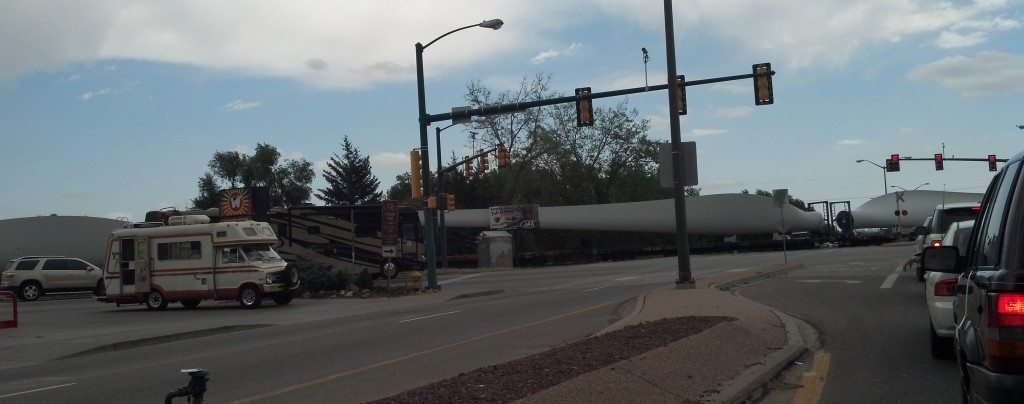
The train carrying wind turbine blades had some trouble passing through Fort Collins, Colo. (Photo by Michael E. Grass)
FORT COLLINS, Colo. — On my way north out of Colorado to link back up with the Lincoln Highway’s route through Wyoming and onward west to San Francisco, I followed U.S. 287 into this city of roughly 145,000 people, according to the 2010 Census, making it the Centennial State’s fourth-largest city.
Driving north from the Jack Kerouac gas station outside Longmont and into Loveland, where Lincoln Avenue carries northbound traffic through the center of the city, the mountains of the Front Range frame the western horizon. Longs Peak, a 14,255-foot mountain is the highest point in this part of the state, though it’s only Colorado’s 15th-highest.
Peakbagger.com has described the mountain as “a craggy monster with several enormous vertical cliffs, set among the sea of 13,000 foot peaks that make up Rocky Mountain National Park.”
Fort Collins a hub for the northern Front Range, home of Colorado State University‘s flagship campus and a number of great local breweries, including New Belgium Brewing Co., Equinox Brewing, Odell Brewing Co. and The Fort Collins Brewery. Anheuser-Busch has a large facility here, too.
It was mid morning and, unfortunately, too early to take a break to sample the local beer. (I have had may fair share of beer brewed by New Belgium over the years.) On my way out of town, I was actually contemplating turning back when a freight train carrying wind-turbine blades blocked my route to Cheyenne, Wyo.
Post continues below …

Another look at the train carrying wind-turbine blades through Fort Collins, Colo. (Photo by Michael E. Grass)
The train moved slowly through the railroad crossing at E. Mulberry Street and Riverside Avenue. (I was headed east to connect with Interstate 25, which has replaced parts of the Lincoln Highway’s Colorado Loop between Fort Collins and Cheyenne, according to the Lincoln Highway Association’s official map.
Vehicular traffic began to back up as the series of flatbed train cars slowly moved on through. Then, the train lurched and came to a sudden stop. Anyone nearby could hear the gigantic wind-turbine blades, the chains and supports holding them in place and the succession of flatbed rail cars loudly shake.
And then train sat there. One minute turned into two minutes which turned into five minutes. More cars backed up. There was a gas station on the corner, so I decided to be efficient with the delay and fill up my tank.
As I was pumping, the train started up again and moved forward. Then it lurched and shuddered to a stop again. A minute or so later, the train reversed course. Traffic continued to build.
After I was finished pumping gas, I decided to drive around the train, which was carrying about 10 of these turbine blades, and my five-mile detour got me to I-25 without too much delay.
On my way out of town, I was thinking about all the wind turbines I’d seen on my Lincoln Highway trip. At first, I was excited to see them — like in Somerset County, Pennsylvania, and Van Wert County, Ohio. Then as I continued west, I kept on seeing more, especially in north central Illinois and Iowa. After awhile, these structures became part of the normal landscape.
Taking a look at the states I’ve traveled through on this trip, it seems that the Lincoln Highway’s route travels through some top wind-generating territory.
According to the U.S. Department of Energy, at the end of 2012, Pennsylvania had 1,340 megawatts of wind-power capacity, Ohio had 426 megawatts, Indiana had 1,543 megawatts, Illinois had 3,568 megawatts, Iowa had 5,137 megawatts, Nebraska had 459 megawatts and Colorado had 2,301 megawatts.
Colorado utilities have been interested in expanding the state’s wind-power capacity to 2,700 megawatts, according to the Denver Business Journal.
Look for more freight trains carrying wind-turbine blades. According to the Union Pacific Railroad, it transported delivered nearly “6,000 carloads of towers, nacelles, hubs and blades to destinations around the United States” in 2012.
As Inbound Logistics points out in an article about transporting wind-power parts to California via barge, moving these components is not easy, especially by truck:
Scheduling the required highway patrol escorts was also an issue. If moved by truck, each three-section tower—consisting of base, middle, and top pieces—would need an escort. The nacelles and blades would require additional trailers and escorts. Coordinating drivers, escorts, permits, and specialized equipment to move all the parts would be a monumental task.
The freight train, too, as I found out in Fort Collins, has its share of logistical challenges.

Pretty cool sight, though! Those blades look a lot bigger up close.